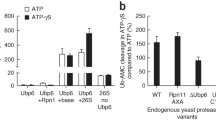Abstract
We have developed S. cerevisiae as a model system for mechanistic studies of the 26S proteasome. The subunits of the yeast 19S complex, or regulatory particle (RP), have been defined, and are closely related to those of mammalian proteasomes. The multiubiquitin chain binding subunit (S5a/Mcb1/Rpn10) was found, surprisingly, to be nonessential for the degradation of a variety of ubiquitin-protein conjugates in vivo. Biochemical studies of proteasomes from Δrpn10 mutants revealed the existence of two structural subassemblies within the RP, the lid and the base. The lid and the base are both composed of 8 subunits. By electron microscopy, the base and the lid correspond to the proximal and distal masses of the RP, respectively. The base is sufficient to activate the 20S core particle for degradation of peptides, but the lid is required for ubiquitin-dependent degradation. The lid subunits share sequence motifs with components of the COP9/signalosome complex, suggesting that these functionally diverse particles have a common evolutionary ancestry. Analysis of equivalent point mutations in the six ATPases of the base indicate that they have well-differentiated functions. In particular, mutations in one ATPase gene, RPT2, result in an unexpected defect in peptide hydrolysis by the core particle. One interpretation of this result is that Rpt2 participates in gating of the channel through which substrates enter the core particle.
Similar content being viewed by others
References
Löwe J, Stock D, Jap B, Zwickl P, Baumeister W & Huber R (1995) Science 268: 533–539
Baumeister W, Walz J, Zuhl F & Seemuller E (1998) Cell 92: 367–380
Pickart C (1997) FASEB J. 11: 1055–1066
Glickman MH, Rubin DM, Fried VA & Finley D (1998) Mol. Cell. Biol. 18: 3149–3162
Hoffman L & Rechsteiner M (1994) J. Biol. Chem. 269: 16890–16895
DeMartino GN, Moomaw CR, Zagnitko OP, Proske RJ, Ma CP, Afendis SJ, Swaffield JC & Slaughter CA (1994) J. Biol. Chem. 269: 20878–20884
Groll M, Ditzel L, Löwe J, Stock D, Bochtler m, Bartunik HD & Huber R (1997) Nature 386: 463–477
Fujimuro M, Tanaka K, Yokosawa H & Toh-e A (1998) FEBS Lett. 423: 149–154
Patel S & Latterich m (1998) Trends Cell Biol. 8: 65–71
Beyer A (1997) Prot. Sci. 6: 2043–2058
Finley D, et al. (1998) Trends Biochem. Sci. 23: 244–245
Deveraux Q, Ustrell V, Pickart C & Rechsteiner M (1994) J. Biol. Chem. 269: 7059–7061
Deveraux Q, Jensen C & Rechsteiner M (1995) J. Biol. Chem. 270: 23726–23729
van Nocker S, Sadis S, Rubin DM, Glickman MH, Fu H, Coux O, Wefes I, Finley D & Vierstra RD (1996) Mol. Cell. Biol. 11: 6020–6028
van Nocker S, Deveraux Q, Rechsteiner M & Vierstra RD (1996) Proc. Natl. Acad. Sci. 93: 856–860
Kominami K, Okura N, Kawamura M, DeMartino GN, Slaughter CA, Shimbara N, Chung CH, Fujimura M, Yokosawa H, Shimizu Y, Tanahashi N, Tanaka K & Toh-e A (1997) Mol. Biol. Cell 8: 171–187
Haracska L & Udvardy A (1997) FEBS Lett. 412: 331–336
Haracska L & Udvardy A (1995) Eur. J. Biochem. 231: 720–725
Young P, Deveraux Q, Beal RE, Pickart CM & Rechsteiner M (1998) J. Biol. Chem. 273: 5461–5467
Fu H, Sadis S, Rubin DM, Glickman MH, van Nocker S, Finley D& Vierstra RD (1998) J. Biol. Chem. 273: 1970–1989
Glickman MH, Rubin DM, Coux O, Wefes I, Pfeifer G, Cjeka Z, Baumeister W, Fried VA & Finley D (1998) Cell 94: 615–623
Hofmann K & Bucher P (1998) Trends Biol. Chem. 23: 204–205
Aravind L & Ponting CP (1998) Prot. Sci. 7: 1250–1254
Wei N, Tsuge T, Serino G, Dohmae N, Takio K, Matsui M & Deng, XW (1998) Curr. Biol. 8: 919–922
Seeger M, Kraft R, Ferrel K, Bech-Otschir D, Dumdey R, Schade R, Gordon C, Naumann M & Dubiel W (1998) FASEB J. 12: 469–478
Wolf S, Nagy I, Lupas A, Pfeifer G, Cejka Z, Müller SA, Engel A, De Mot R & Baumeister W(1998) J. Mol. Biol. 277: 13–25
Zwickl P, Woo KM, Klenk HP & Goldberg, AL (Submitted).
Rubin DM, Glickman MH, Larsen CN, Dhruvakumar S & Finley D (1998) EMBO 17: 4909–4919
Lupas A & Baumeister W (1997) Trends Biochem. Sci. 22: 195–196
Gottesman S, Maurizi MR & Wickner S (1997) Cell 91: 435–438
Gottesman S, Wickner S & Maurizi MR (1997) Genes Devel. 11: 815–823
Hershko A, Leshinsky E, Ganoth D & Heller H (1984) Proc. Natl. Acad. Sci. USA 81: 1619–1623
Ditzel L, Lowe J, Stock D, Stetter KO, Huber H, Huber R & Steinbacher S (1998) Cell 93: 125–138
Fenton WA & Horwich AL (1997) Protein Science 6: 743–760
Horovitz A (1998) Curr. Op. Struc. Biol. 8: 93–100
Kim S, Willison KR & Horwich AL (1994) Trends Biochem. Sci. 19: 543–548
Ghislain M, Udvardy A & Mann C (1993) Nature 366: 358–361
Schnall R, Mannhaupt G, Stuka R, Tauer R, Ehnle S, Schwarzlose C, Vetter I & Feldmann H (1994) Yeast 10: 1141–1155
Russell SJ, Sathyanarayana UG & Johnston SA (1996) J. Biol. Chem. 271: 32810–32817 28
Chu-Ping M, Vu JH, Proske RJ, Slaughter CA & DeMartino GN (1992) J. Biol. Chem. 269: 3539–3547
Hough R, Pratt G & Rechsteiner M (1986) J. Biol. Chem. 261: 2400–2408
Hough R, Pratt G & Rechsteiner M (1987) J. Biol. Chem. 262: 8303–8313
Asano K, Vornlocher HP, Richter-Cook NJ, Merrick WC, Hinnebusch AG & Hershey JWB (1997) J. Biol. Chem. 272: 27042–27052
Asano K, Kinzy TG, Merrick WC & Hershey JWB (1997) J. Biol. Chem. 272: 1101–1109
Author information
Authors and Affiliations
Rights and permissions
About this article
Cite this article
Glickman, M.H., Rubin, D.M., Fu, H. et al. Functional analysis of the proteasome regulatory particle. Mol Biol Rep 26, 21–28 (1999). https://doi.org/10.1023/A:1006928316738
Issue Date:
DOI: https://doi.org/10.1023/A:1006928316738




